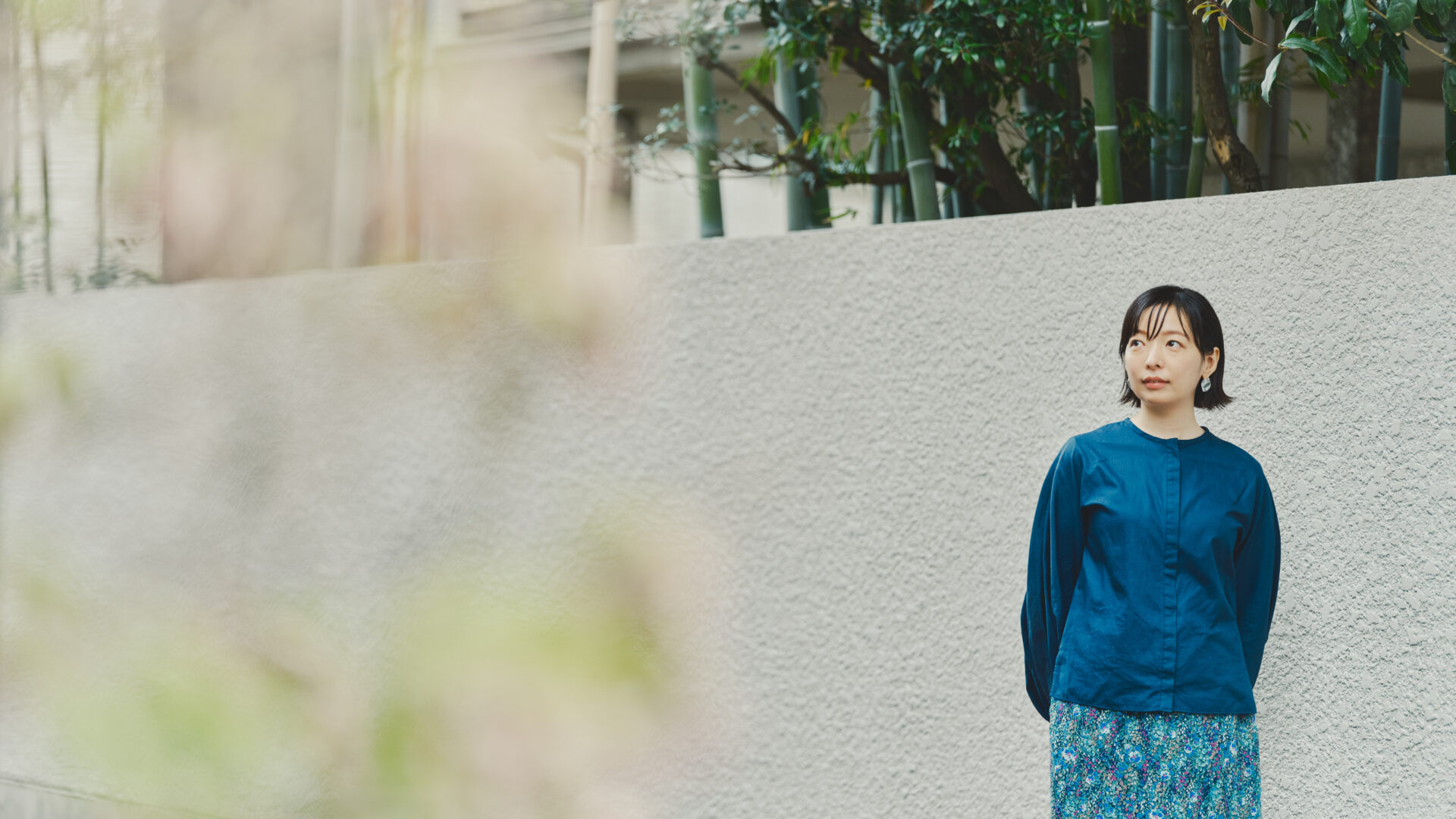A dignified presence and a gentle transparency.
They do not overly assert their presence, nor do they dominate the space with fancy vibes.
Somehow, their presence alone melts the air in the room and uplifts the heart of its owner.
The products created by designer Shizuka Tatsuno have a balance of intelligence and a respect for craftsmen that deliver special moments in the daily lives of those who own them.

“Look at what I found. Isn’t it lovely?”
When looking at Tatsuno’s products, you feel as if she is speaking directly to you.
Tatsuno finds charming and special craftwork from all over the world and helps to design them into products that match the modern day lifestyle. Traditional and modern, essentials and non-essentials, design and art. All the boundaries that distinguish each other are melted with ease through her products.
Tatsuno is also deeply involved in the practice of the Japanese tea ceremony. We talked to her about her history and how she creates special experiences through her designs
Bizen pottery, an amalgamation of traditions and modern culture

── I use the bizen pottery cup “hitoe” that you designed and enjoy it very much. In a past DIG THE TEA article, we visited a restaurant that used the water carafe “hiiro.” How did these products come to be?
There was a project run by The Association for the Promotion of Traditional Craft Industries which connected designers with craftsmen. The designers are allowed to work with any of the participating craftsmen and I was attracted to bizen pottery. I was very optimistic about its potential and so I made contact with the craftsmen. That was the start of the project.
I did some more research on bizen pottery and found that there are old sayings about it that say, “Bizen pots will not leak even if they are tossed” and “Water in a Bizen bottle will not spoil.” In reality, water does go bad eventually, but bizen pottery is known for helping to keep flowers fresher for longer and improving the flavor of water. I was very impressed to learn that even though no special chemical is added to the water, the pottery itself has the effect of changing the quality of the water.
Since bizen pottery has such a direct effect on water, I thought we could promote it better by creating water jugs. My suggestion eventually led to the production of the water carafe “hiiro.”
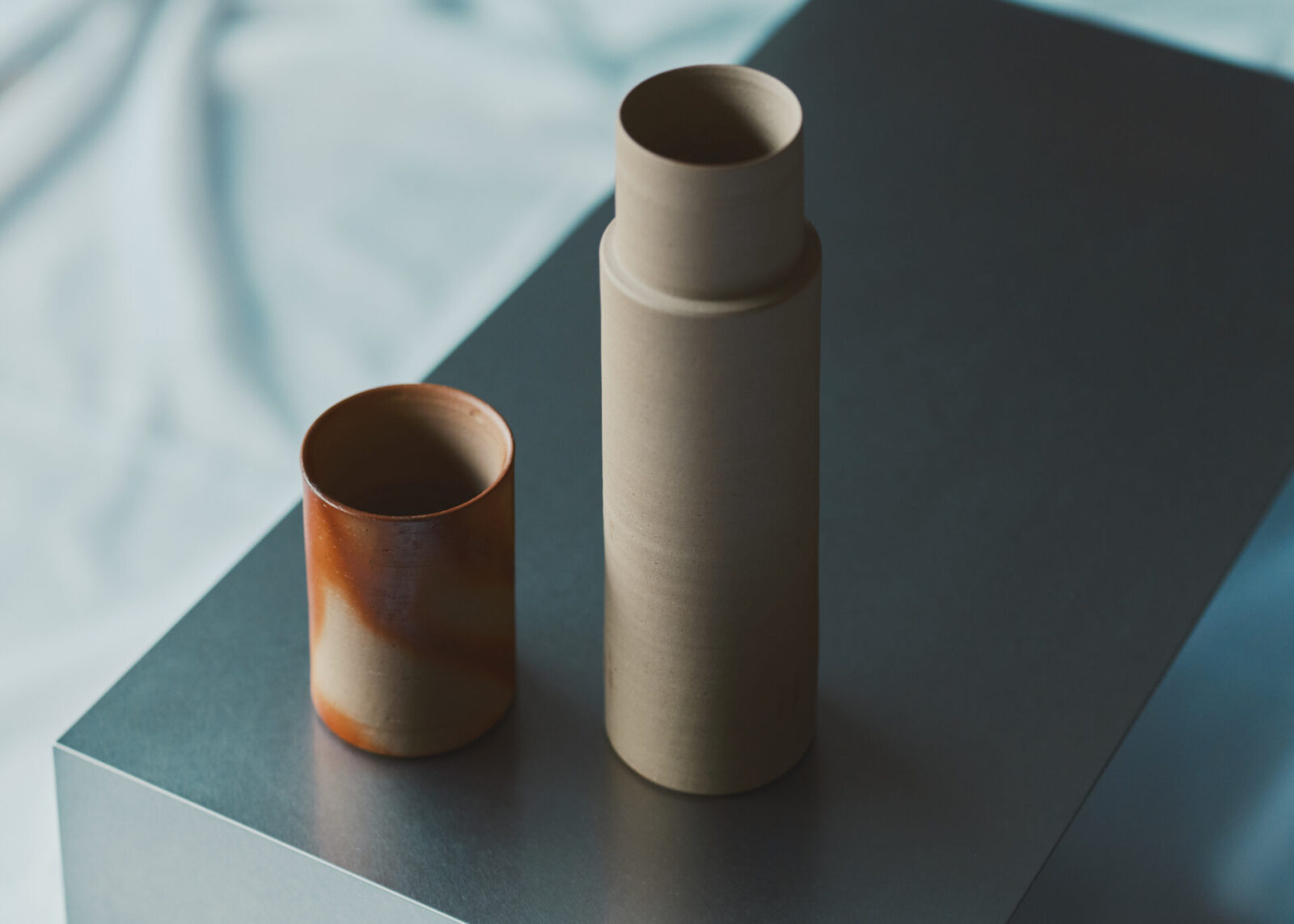
The craftsmen also had a desire to enter the European market and were planning on an exhibition in Germany. We focused on creating a minimalistic design to match German tastes and created a product that would match the needs of European lifestyles. We intentionally mixed coarse sand with soil to give it a natural texture and paid attention to details to avoid making it too plain. The subtle texture of the product can only be achieved through deliberate detailed work.
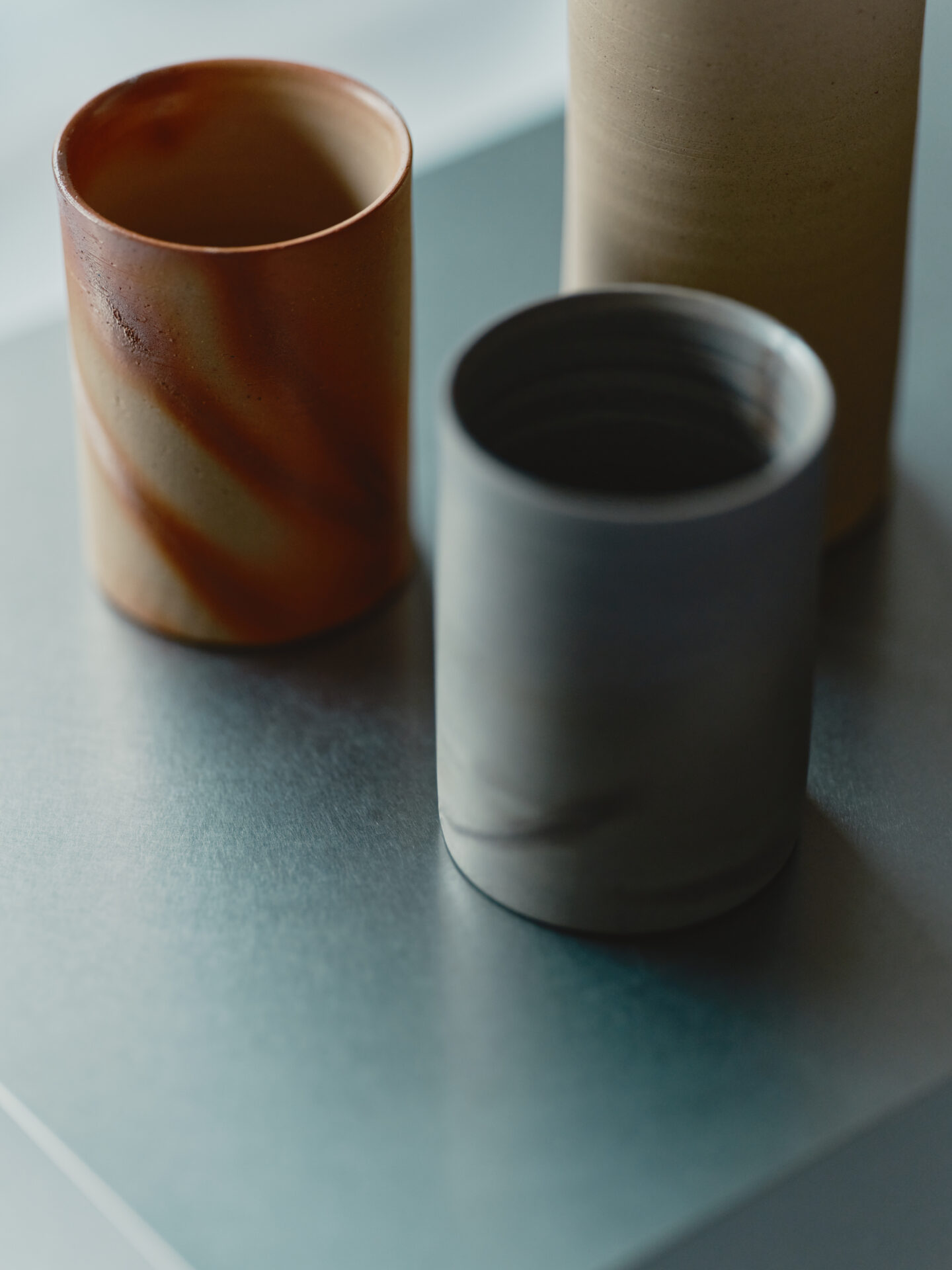
Studying art and design in England
── How did you become interested in design work in the first place?
I was born and raised in Omotesando and that really had a lot of influence. Ever since I was a child, I was drawn to art and design and I knew that I had a knack for it. I hoped to one day be a part of that world.
Of all the different genres that exist in arts and crafts, the reason I chose product design was largely influenced by the popularity of home furniture that was in full swing when I was in high school. In the time prior to choosing an area to major in at university, I had already seen a lot of products that I thought were really cool.
I also remember reading “Easy Living” written by Terence Conran, a top designer of the British design world, when I was a teenager. I was so surprised to learn that there are people who study and deeply contemplate such details of comfortable everyday living.
If there were other inspirations, I may have studied graphic design or fashion. That is how widely I was attracted to the world of design.
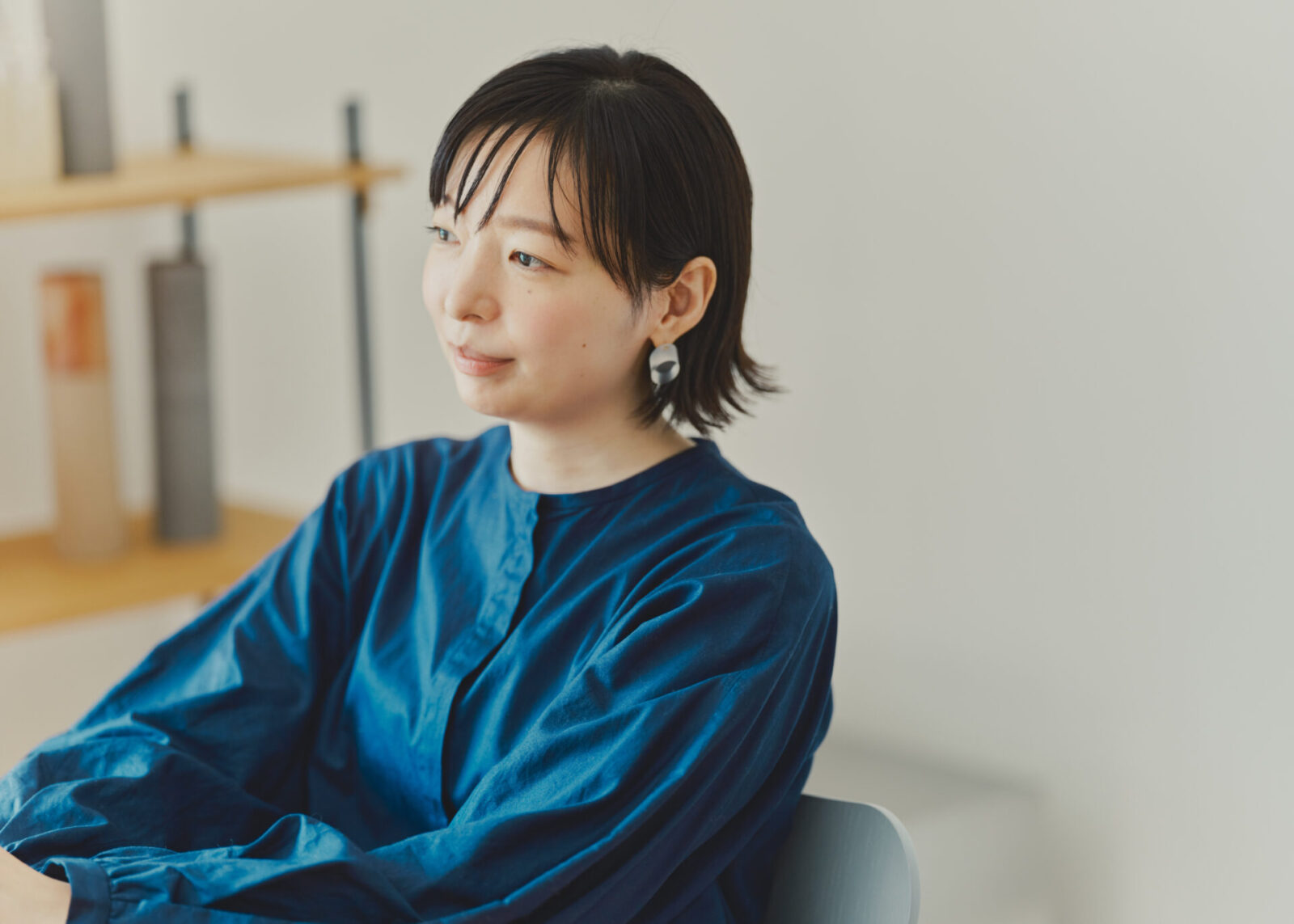
── You studied abroad at a university in London. What are some of the things you learned through your experience there?
You can really get a sense that there is a strong culture of support for design in England. One example is how museums are free of charge in central London. The residents of London come from all over the world and you are exposed to different cultures everyday so it made me much more open-minded. Japan is very strict with time, but in London it is expected that everything will be 15 minutes late. I think it is a difference of where we put our priorities, but in this kind of laxness I learned that the world moves in different ways and each has its positive aspects.
── You began working in Japan and became independent at the age of 27. Was that always your plan?
It was during my time in England that I realized the true excellence of Japanese crafts and I was looking to work at a place where I could be involved in that area. However, when I was a student, there weren’t any jobs that allowed you to be involved in traditional crafts and design so I came to the conclusion that I would have to do it independently. After I graduated, I got a job at a graphic design company but in my mind I knew I was going to become independent so my aim was to gain the necessary skills to do so on the job.
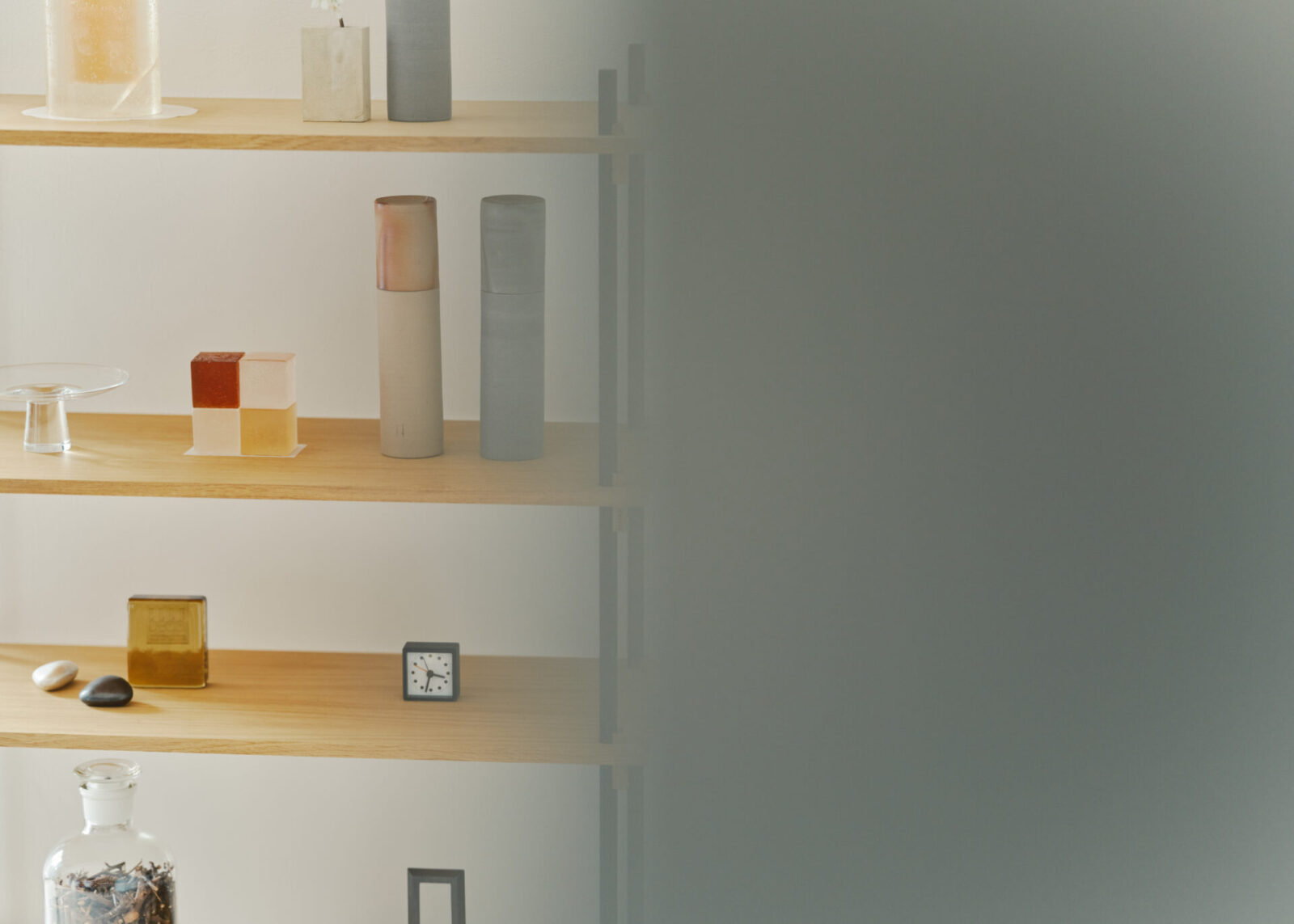
── Was there anything in particular that prompted you to finally become independent?
I think there were a few things.
One of which was particularly significant was that there was a writer for the Elle Decor interior design magazine that had shown interest in me ever since seeing my graduation project at my university. Even after I graduated and started working for a company, I received a long email asking me about my future plans and to contact them if I work on any projects in the future. Shortly after I became independent, they came to write a story on my project and showed my products in their magazine so it was very helpful.
Looking back, I had received job offers and media coverage both internationally and in Japan when I presented my graduation project, so I had a feeling that I should not wait too long before going independent.
Giving shape to “invisible” colors
ーー Are there any particular products that you worked on that you feel especially fond of?
One of my favorite works is the “Hydrangea” which was designed as a part of the Koraicraft brand series and it is based on a memory from my childhood.

We were talking about creating products under the concept of “senseware,” or products that spark sensations and emotions, and that idea made me recall a childhood memory.
It was a memory of when my mother filled a glass bowl with water and placed it on the windowsill. I remember how that simple act reflected light from the water onto the ceiling and it made the room so beautiful. The scene it created was really something special. That simple act of adding water to a bowl brought beautiful light and movement into the house. This matched the concept that we were looking for and gave birth to the “Hydrangea” product.
── The “Hydrangea” brings light into a space and brings a dignified air to the room just by being there. Do you have any other products that you are particularly proud of?
A recent product I worked on is called “Fuyu no Sakura” (winter cherry blossom). This is a sculptural candy piece that is made from sugar and water. It is a piece I made as a personal project and not for a client. For this exhibition project, I made various products based on the theme of “cherry trees awaiting spring.” After I became independent, most of my work was for clients, but I believe it is important to work on things that stimulate my personal interests so I started creating my own products last year, which was my tenth year of working independently. In our current day and age, there are immeasurable new ideas and values that emerge all the time so I try to keep my mind active.
The “Fuyu no Sakura” is not a piece that came to mind on its own. I had many ideas that I thought about for a long time that came together to create this piece.
Take plant dyeing for example. The colors extracted from natural plants change depending on the health and environment of that plant. I was intrigued by the fact that there is a beauty about it that is beyond our control and so I started reading books about it. Fukumi Shimura, a dyeing and weaving artist, wrote that she looks at flowers while envisioning what kind of color it will produce. I thought that way of living was very lovely. I thought, how enriching it is to see the world through an expansion of your imagination and trying to see things that exist but cannot be seen in that moment.
For the “Fuyu no Sakura,” I gathered fallen branches, branches from wilted trees and pruned cherry branches with flower buds from gardens in Yoyogi Uehara, Nakameguro, and Kobe. I extracted the colors using a plant dyeing technique. The fallen cherry tree branches produced a yellow color, while the branches with the buds created a light pink color.
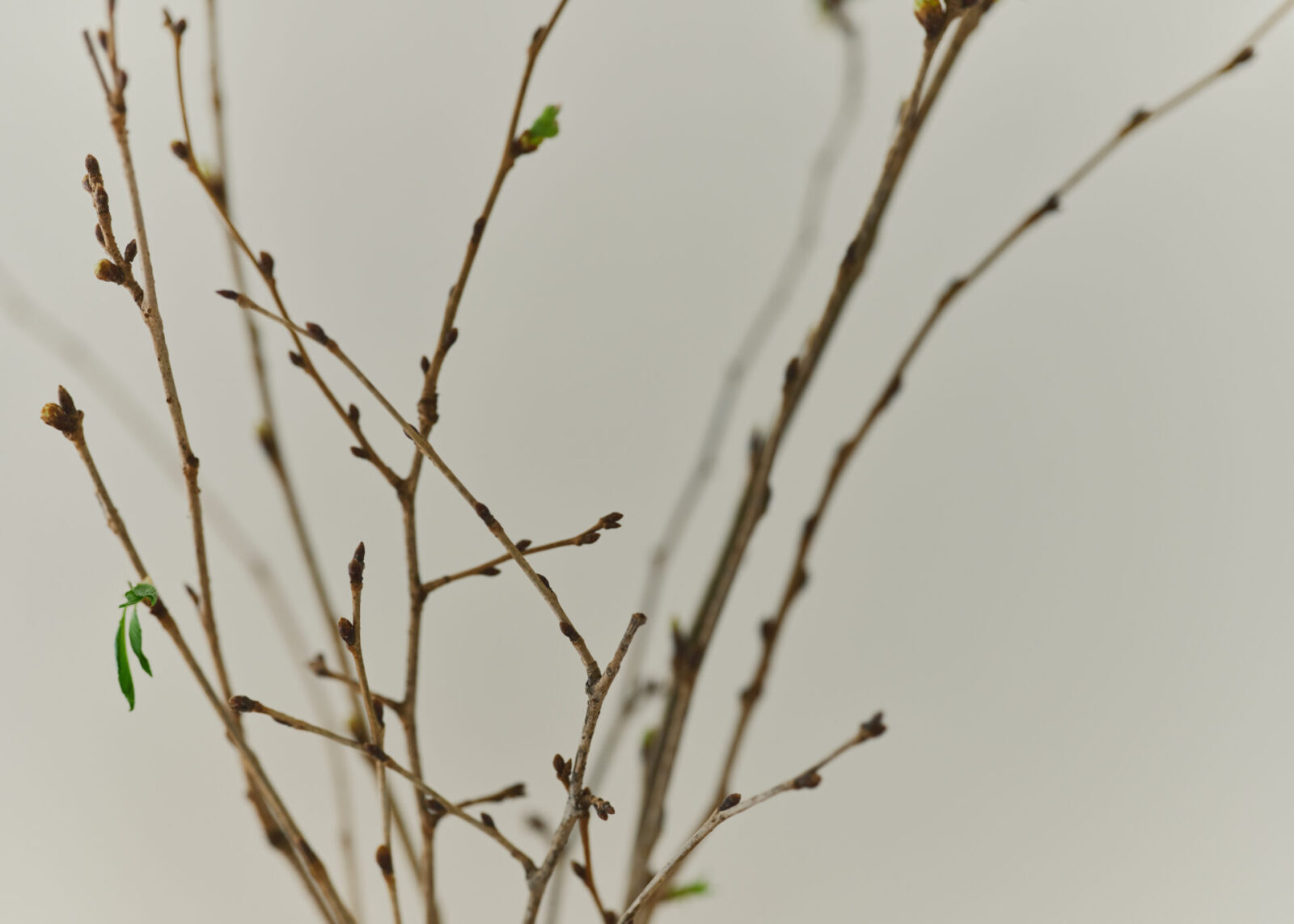
── Extracting colors from plants that cannot be seen on the outside and using them in your work must be a very deep process.
It really is. I also really like transparent materials. I came up with the idea of using candy for this piece in 2020, when I was asked to produce a piece for the opening of the
“Nadoya Yoyogi Uehara” gallery that opened in Yoyoki Uehara in 2021. At the time, the idea that candy would make a good biodegradable yet transparent material was already in my mind and I decided that I would color the candy with colors extracted from plants.
“Nadoya” was in Ebisu until March, 2022 and I learned that there was a plum tree that would be cut down due to the demolition of a nearby building. I saw how much the owner loved that plum tree so I wanted to create a piece using color extracted from its branches. Plant dyeing is often associated with Japanese paper and cloth, so I was thinking about what other materials it can be used on and came up with the idea of using candy.
The great thing about candy is that it does not retain its shape permanently. It melts and then crystallizes, and the fact that it changes shape in the way that flowers and trees change color and shape felt like a good match.
The cherry blossoms were very beautiful again this year, and I believe people enjoy them so much because they can only be enjoyed for a short period of time. I also wanted to express the beauty of something that gives people a sensation of being in the moment. I am a fairly systematic person when it comes to my design work, but when I first envisioned the plum candy piece, I found that my mind could not keep up with what I wanted to express in terms of the meaning behind the piece so I found that it had a more intuitive value. A part of me wanted to be experimental and turn something I felt as true through my senses into a visible product.
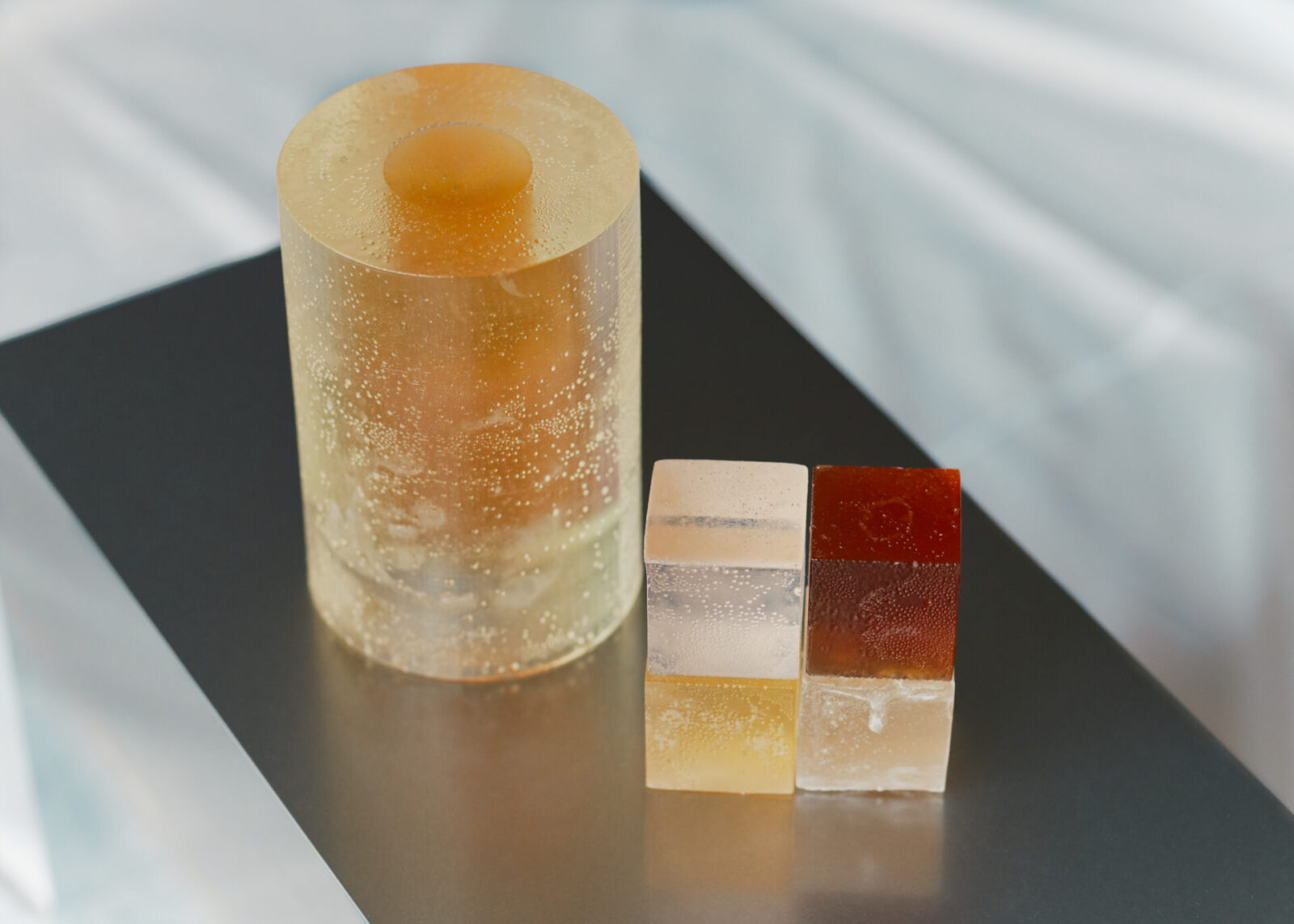
── Experimenting for yourself must be important.
Later, I received an invitation from curator Reiko Itabashi, who had seen my solo exhibition at the “Nadoya Yoyogi Uehara” gallery, to participate in a exhibition called “Mother nature.” The exhibition was in Nakameguro, which is well known for its cherry blossoms, so rather than using plum trees, I decided cherry trees would be a better match. Since it was winter, I focused on winter cherry trees.
While I was experimenting with extracting color from the branches, I found that in the winter, the branches had already started to prepare the color for the flowers. It is said that cherry branches produce their strongest color when they are in bud and during the summer, so I didn’t think the winter branches would have any color. However, it turned out that they produced a light pink color.
No matter how cold it was or how much snow fell onto its branches, the cherry tree was alive and preparing for blossom in spring. I wanted to express the beauty of the winter cherry tree in my work. Before, I looked at winter cherry trees as barren branches, but now I feel a deep affection for them.

Conveying the inherent appeal of the craft
── What do you think is important when making a product or designing a piece?
In regard to making products, the word that comes to mind is “respect.”
This is also the word that describes my experience with visiting a Satsuma Kiriko studio (Satsuma cut-glass). I try to visually express the craftsman’s techniques and client ideas that I find fascinating and everything that encompasses them into my work. In the past, I also worked with Edo Kiriko (Edo cut-glass), and my first question was, “What is the difference between Satsuma Kiriko and Edo Kiriko?” The more I learned from the craftsman, the more I understood how they have different charms.
Edo Kiriko is made by cutting thin glass, but Satsuma Kiriko cuts thick glass. The Satsuma Kiriko has more depth so that is why they are able to create color gradation on the cut surface. My “grad. ice” product was designed to clearly express the joy that comes from seeing that distinctive gradation.
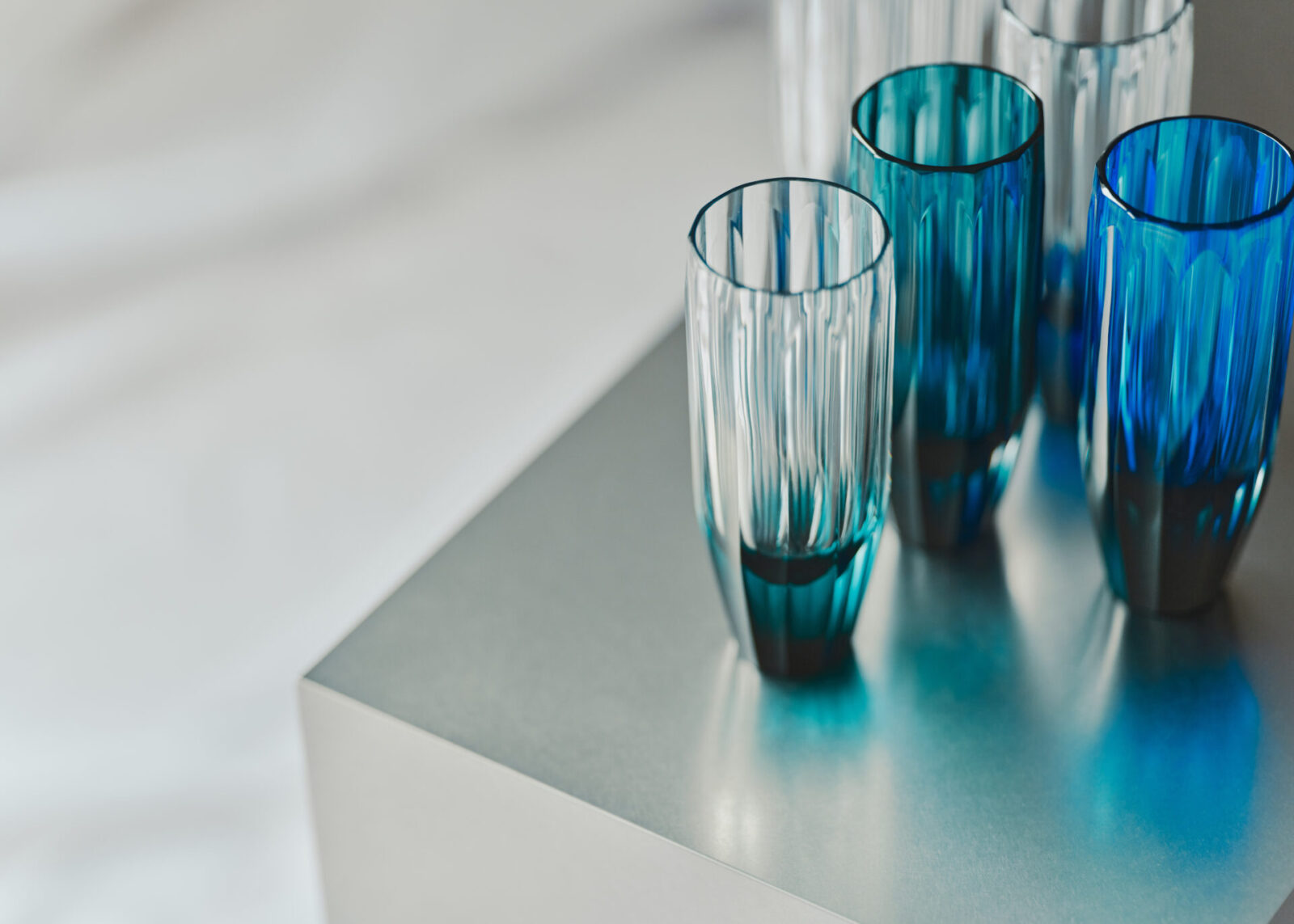
This is true for all of my products, but I am careful about how I express the inherent appeal of a craft. Besides that, I think I simply want to share what I find to be wonderful with other people.
Pursuing comfort through tea ceremonies
── You work as a designer, but we also heard you also practice Japanese tea ceremonies.
I began studying the art of Japanese tea ceremonies before I went to England because I felt that I did not know much about my home country. I continue to practice it today and it is becoming an essential part of my life. I find that it keeps overlapping and emerging in my life.
── Your life and tea ceremonies overlap?
Yes. The world of the tea ceremonies is very deep, so I want you to understand that what I am saying is only a small part of it, but I think the tea ceremony is like a “path” that questions the way you live your life.
Tea ceremonies are an act of hospitality in which we serve tea to guests. In order to properly achieve the spirit of altruism and the desire to please others, the person who is serving must also be properly satisfied in life. For example, when you are suffering mentally inside, you cannot provide good hospitality. I think tea uses the teachings and philosophies of zen to train and help us find this path of proper hospitality.
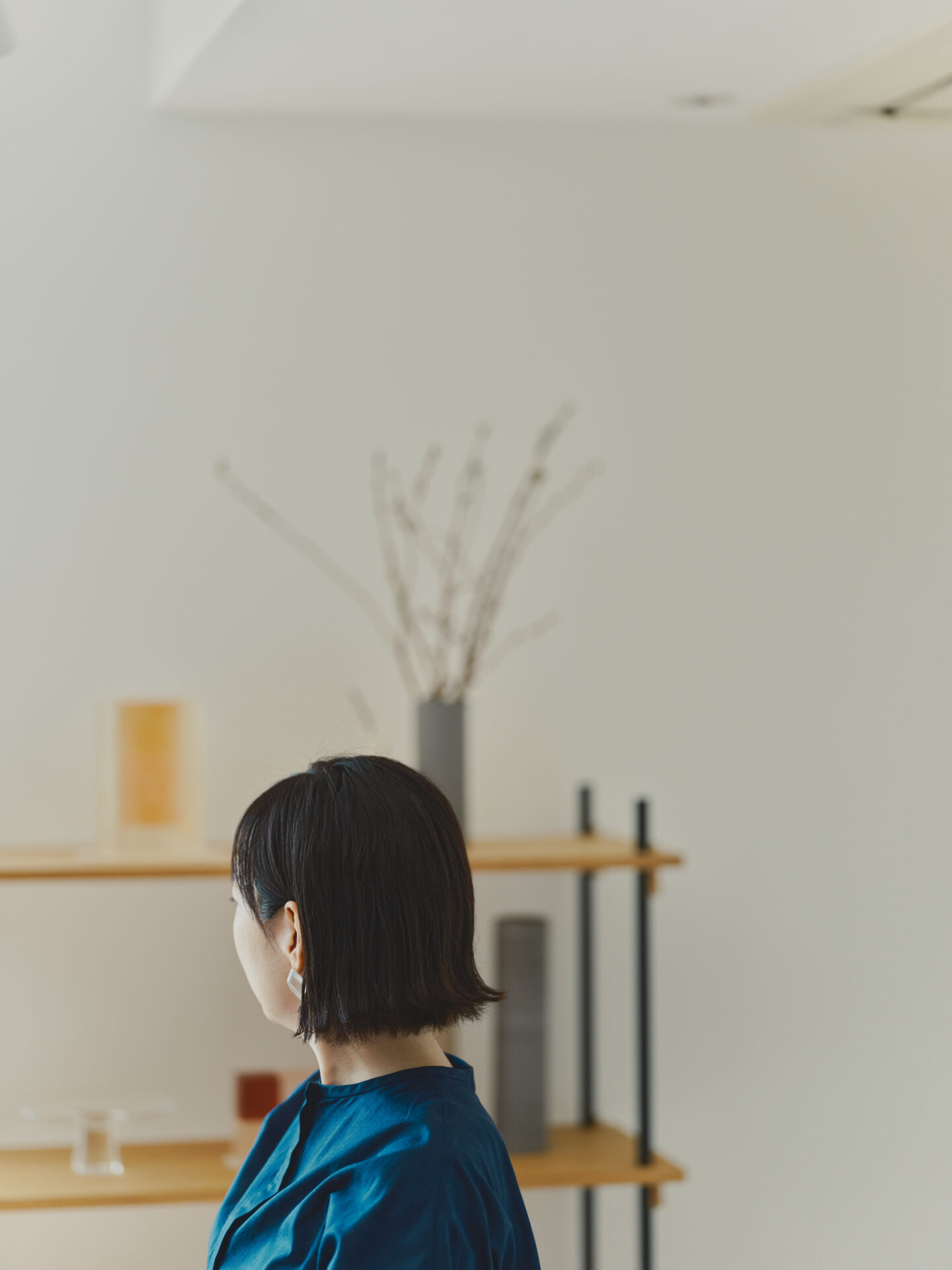
There is the saying “shikantaza,” which means to meditate while focusing on just one thing. It teaches us the importance of concentrating on what is in front of you and not getting distracted by everything else that is going on around or inside you. This teaching is similar to the philosophy behind the tea ceremony and it is a phrase I keep close at heart.
Even the same teachings and words will give us different feelings at different moments. Through the tea ceremony I learn a lot about my own current state and it acts as a guiding post when I think about my future.
── Between your work in design and exhibitions, you must have a very busy schedule. How do you spend your time when you want to relax?
Besides practicing tea, it’s also very important for me to take walks. We live in the age of information and our minds are often exhausted, but when I walk I am able to settle my mind. When I take my walks, I choose not to wear earphones.
While walking I often take notice of minor details, like what kind of birds are visiting the Meguro river right now. Some people may find this information to be useless, but I sometimes find different species of birds getting along by the river and you cannot take notice of such things if your mind is distracted.
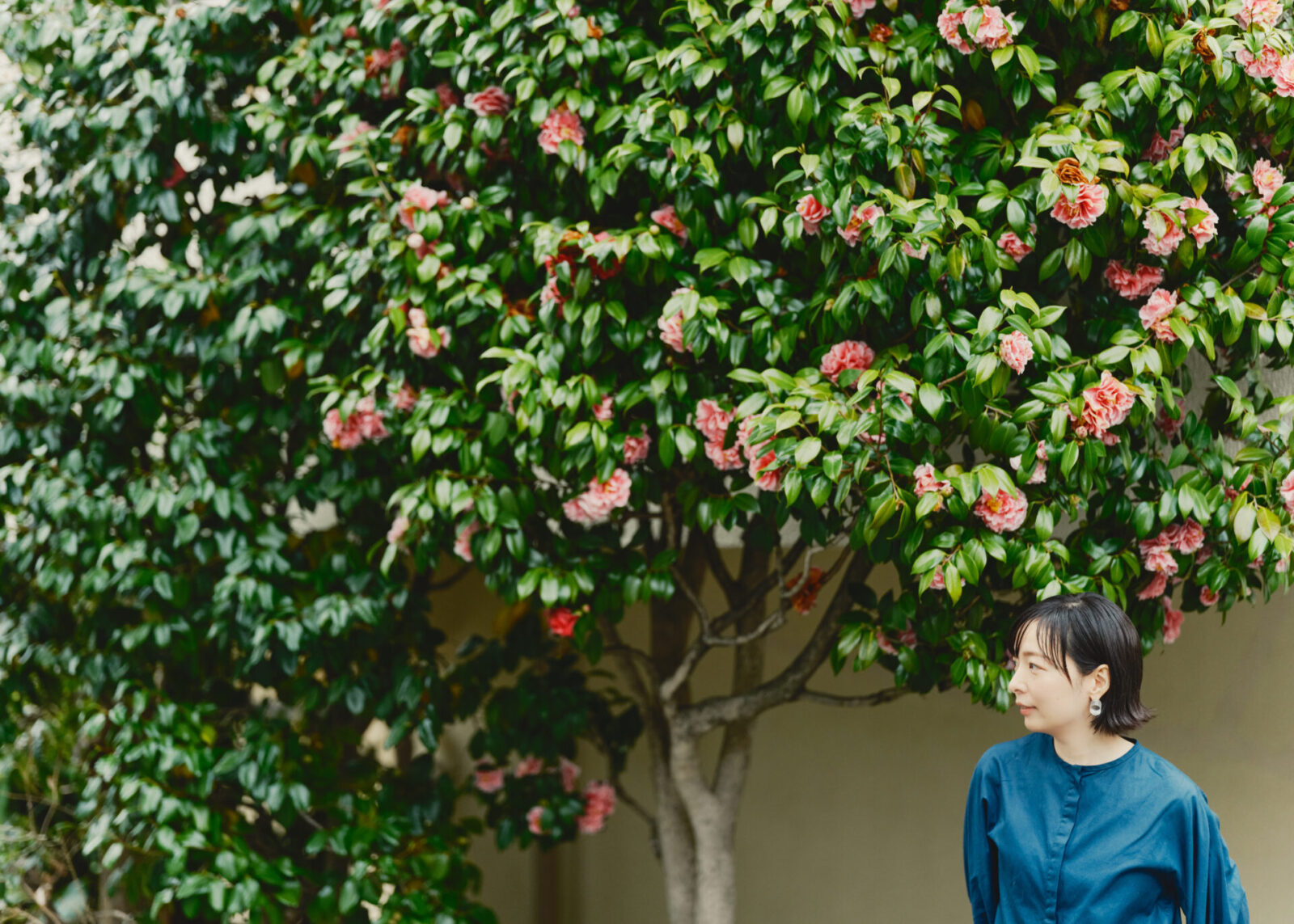
── What do you think about the importance of treasuring things that you take pleasure in, even if it may not be considered “essential” in life?
I think that it is different for everyone so it is hard to answer, but speaking for myself I like to incorporate fragrance into my life. I don’t wear perfume, but I have a lot of aroma oil sprays and I choose the fragrance that matches my mood. I incorporate it into my life to bring comfort to my inner self.
The “Hydrangea” and similar products are another example, and these are something that some people may consider “non-essential.” As the creator of these products, I hope that these designs help people find beauty in their everyday life, but everyone’s desires and what they wish to incorporate into their lives are also different. We all have our pursuits for how to find comfort to fill in the voids in our lives. For me, it is fragrances, but in the same way, some people like to have flowers in their home.
I personally believe that a space that is designed to create comfortable moments also encourages inspiration. This office also has an earthy energy to it so I enjoy the space very much.
With the pandemic, our world has implemented a more remote approach to work so I have an even bigger appreciation now for the power of space. In the future, I hope to work on furniture and light fixtures and designing spaces. Light has a big influence on how we control and feel a space so I am very interested in it.
Photo: Eichi Tano
Translation: Sophia Swanson
Editor and creator of the future through words. Former associate editor of Huffington Post Japan. Became independent after working for a publishing company and overseas news media. Assists in communications for corporates and various projects. Born in Gifu, loves cats.
